Mental
In 1903 building work began to the west of the Horton Asylum for the next mental facility planned by the LCC - the fourth institution of the Epsom cluster to be built on the Horton estate.
Because of the damage caused to the local country roads by the constant delivery of building materials during the construction work on the previous Asylums, the contractors, Forster & Dickie, obtained a light railway order. They purchased 40 acres of land and the necessary sidings from the London & South West Railway Company at the cost of £10,000, and built a standard gauge railway to bring in workmen from London and building supplies. The first train-load of bricks and cement was delivered by the Long Grove Light Railway in April 1905.
Named after a nearby area of woodland, Long Grove Asylum opened in 1907. It had been built to almost the same design as the Bexley Hospital, as had its sister asylum, Horton Asylum. (Re-use of an already approved plan enabled the LCC to get swifter approval from the Commissioners in Lunacy than would a completely new plan.)
Built of red brick with courses of yellow brick banding, the Asylum could accommodate 2000 patients. The improved financial situation of the LCC allowed more architectural embellishment and better standards of fittings and equipment than those at Bexley and Horton Asylums.
The central section of the Asylum contained the service buildings - the administration block, recreation hall, kitchens, main stores and staff quarters. The 3-storey administration building was flanked by 8 male and 8 female ward blocks. The female side contained the laundry, while on the male side were the boiler house and workshops. A large semi-circular corridor (open to one side) linked all the wards, while spur corridors linked the wards to the central blocks. The site also contained a water tower, a chapel, infirmary blocks and an isolation hospital. The Medical Superintendent had his own residence, as did other members of the senior staff.
Designed on the echelon plan, each ward block had its own grassed courtyard planted with specimen trees and surrounded by hedges. A central 'bandstand' shelter enabled patients to be outdoors during poor weather.
The extensive gardens were landscaped, with grassland, shrubs and trees providng a sheltered, tranquil environment for the patients.
In 1910 a Nurses' Home was built north of the laundry.
The Asylum was regarded as a showpiece and attracted excellent medical staff. Such was the demand for accommodation that, by 1911, four years after it had opened, there were 2127 patients - 1121 males and 1006 females.
In 1918 it was renamed Long Grove Mental Hospital. In 1937 the word 'Mental' was dropped from its name.
During WW2 Horton Hospital was evacuated and some of its patients transferred to Long Grove. In 1943 a large number of Polish servicemen suffering from neurasthenia were admitted.
The Hospital was unusual in that it accepted typhoid carriersas patients. These female patients, through no fault of their own, were capable of passing on typhoid and so were kept isolated from the main population, as there was no cure for the infection. Between 1943 and 1947, some 43 typhoid carriers - all from the East End of London - had been admitted to the isolation hospital (this closed in 1972 and the patients transferred elsewhere, but still kept in isolation in one of the villas. Today typhoid carriers are allowed to live in the community but are prohibited from working in the food industry).
In 1948, when it had 2163 patients, the Hospital joined the NHS and the South West Metropolitan Regional Hospital Board took over administrative control from the Mental Hospitals Committee of the LCC. Previously, the bed-finding unit at County Hall had allocated patients to any of its mental hospitals, and patients sent to Long Grove could come from any part of London. Under the NHS, the four Metropolitan Regional Hospital Boards introduced catchment areas. The large proportion of mental beds in the South West Metropolitan Region meant that the Epsom hospitals had catchment areas located in the other three regions. The catchment areas for Long Grove Hospital were mainly in the North East Metropolitan Region some 20-25 miles away - the City of London and the Boroughs of Bethnal Green, Finsbury, Hackney, Poplar and Shoreditch - as well as the Borough of Chelsea and part of Hammersmith, in the South West Metropolitan Region.
Under the LCC the Long Grove Hospital provided Medical Officers to attend the Observation Ward at St Pancras Hospital but, with the advent of the NHS, this duty was taken over by University College Hospital.
Staff shortages meant that many wards had to remain closed. At this time there were only 85 full-time female nurses (instead of the full complement of 214). The Hospital employed many part-time nurses, but weekends were sparsely staffed as part-timers attended to their own families. In 1949 a male staff nurse earned £345 per annum, rising by yearly increments of £2 10s (£2.50) to £445. A female nurse was paid £10 a year less. Both were charged £120 per annum for board, lodging and laundry, if they lived in staff quarters (a female nurse did not pay £10 less!).
The patients attended the Occupational Therapy Centre, where they made paper bags, wool rugs, floor cloths, mats, lamp shades, toys, leather goods, string bags, and woven, knitted, crocheted or embroidered articles. These occupations were intended to stimulate retarded and unwilling patients, as well as those needing much supervision, until they were suitable for more useful forms of employment in the laundry, needleroom and kitchens, or in the workshops doing printing, tailoring, shoemaking or upholstering. Male patients also worked on the farm and in the gardens.
After the war, the buildings were improved and redecorated. The Polish patients admitted during the war (some 300) had become chronically mentally ill and their return to Poland remote. Their numbers had swelled when a Polish hospital in Shropshire closed in December 1948. A Polish interpreter was employed full-time at Long Grove and Polish concerts were given for the patients. A Polish priest sometimes held a Mass for them and ladies from the Anglo-Polish Society visited them.
By 1951 the Hospital had 2238 beds.
By 1960, when there were 2151 patients, the Hospital had gained an international reputation for being one of the most advanced and pioneering psychiatric hospitals.
In 1971 the Hospital had 1625 beds, but only 1373 patients. A Regional Adolescent Unit had been established and contained 36 beds.
In 1979 there were 1183 beds. Following the government's policy of returning mental patients to 'Care in the Community'. the Hospital continued to be run down and, by 1985, had only 750 beds.
The Hospital finally closed in 1992. Two of the typhoid carriers were found to be still living there, four decades after antibiotics for the disease had been developed.
In September 1993 the Recreation Hall was set alight, either accidentally by vagrants or by arsonists.
Present status (August 2008)
The site was redeveloped for housing in 1998 and completed in 2002. It is now called 'Clarendon Park'. Most of the buildings were demolished, but a few Hospital buildings remain - the administration building, some ward blocks and the porter's lodge. Many of the open spaces and trees have been retained.
The farmland, south of the Hospital, became part of the the Horton Country Park and contains the Horton Park Children's Farm, a petting zoo.
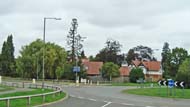
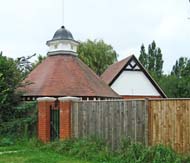
The entrance to the former Hospital (left) with the porter's lodge and what looks like a circular 'bandstand' shelter beside it.
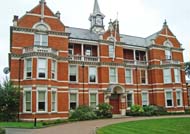
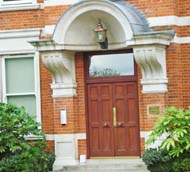
The former administration building, now an apartment block called Prospect House.
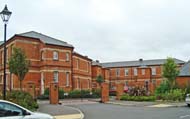
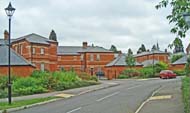
Former ward blocks, now Hunter Court and Harvey Court.
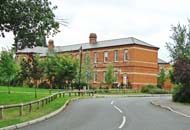
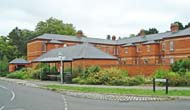
Refurbished ward blocks along Sandy Mead.

Newly built housing is interspersed among the former ward blocks.

The site plan for Clarendon Park.
With the building work completed, the railway line was taken over by the LCC in 1909 and renamed the Horton Light Railway. It was used to bring coal for the power station and boiler house. The track was extended to Sherwood, where a central pumping and power station was under construction to provide power and steam to the Epsom cluster of asylums. However, it was poorly constructed and derailments occurred regularly.
The LCC closed it in 1950 and the track was eventually removed and shipped abroad for other projects.
Abdy C 2001 Epsom Past. Chichester, Phillimore.
Chaplin R, Peters S 2003 Executives have taken over the asylum: the fate of 71 psychiatric hospitals. Psychiatric Bulletin 27, 227-229.
http://derelictmisc.org.uk
http://pb.rcpsych.org (1)
http://pb.rcpsych.org (2)
www.countyasylums.com
www.dailymail.co.uk
www.epsomandewellhistoryexplorer.org.uk
www.epsom-ewell.gov.uk
www.exploringsurreypast.org.uk
www.ihbc.org.uk
www.thetimechamber.co.uk
Return to home page